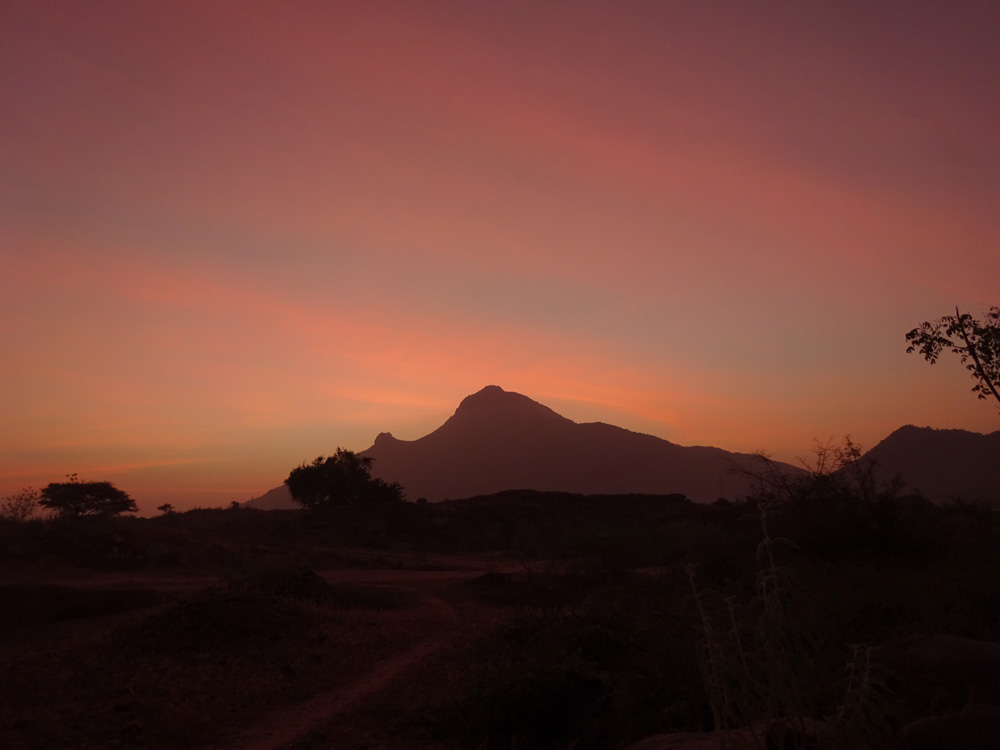
(First published in The Mountain Path, 1982, pp. 75-84.)
By Michael James
The Thought of Arunachala
By seeing Chidambaram, by being born, in Tiruvarur, by dying in Kasi, or by merely thinking of Arunachala, one will surely attain Liberation.
The supreme knowledge (Self-knowledge), the import of Vedanta, which cannot be attained without great difficulty, can easily be attained by anyone who sees the form of this hill from wherever it is visible or who even thinks of it by mind from afar.
This is the fifth of the seven verses that Sri Bhagavan selected from the Arunachala Mahatmyam and translated into Tamil.
Such is the assurance given by Lord Siva in the Arunachala Mahatmyam about the power of the mere thought of Arunachala, and this assurance has received striking confirmation from the life and teachings of Bhagavan Sri Ramana.
In the second line of the first verse of Sri Arunachala Ashtakam Sri Bhagavan tells us that from his very earliest childhood, when he knew no other thing, Arunachala was shining his mind as the ‘most great’. And this thought of Arunachala so worked in his mind that at the age of sixteen a great fear of death arose in him and turned his mind Selfwards to drown forever in its source.
In his writings Sri Bhagavan has repeatedly confirmed the mysterious power that the thought of Arunachala has over the mind. In his Tamil Collected Works, under the picture of Arunachala, there is a verse that can be considered as his dhyana sloka (verse of contemplation) upon his Sadguru, Arunachala Siva.
In this verse he sings, ‘This is Arunachala-Siva, the ocean of grace that bestows liberation when thought of’.
In the first verse of Sri Arunachala Aksharamanamalai (The Marital Garland of Letters) he sings, ‘O Arunachala, you root out the ego of those who think of you in the heart as “Arunachala”’.
In the 102nd verse of Aksharamanamalai, he sings, ‘O Arunachala, the moment I thought of Arunai [the mountain or the town of Tiruvannamalai] I was caught in the trap of your grace. Can the net of your grace ever fail?’
And in the last line of the second verse of Sri Arunachala Navamanimalai (The Necklet of Nine Gems) he sings, ‘Mukti ninaikka varul Arunachalam,’ meaning, ‘Arunachala, the mere thought of which bestows liberation’.
But only in the tenth verse of Sri Arunachala Patikam does Sri Bhagavan actually reveal how the thought of Arunachala works in the mind to root out the ego. In this verse he sings:
I have seen a wonder, a magnetic hill that forcibly attracts the soul. Arresting the activities of the soul who thinks of it even once, drawing it to face itself, the One, making it thus motionless like itself, it feeds upon that sweet [pure and ripened] soul. What a wonder is this! O souls, be saved by thinking of this great Arunagiri, which shines in the mind as the destroyer of the soul [the ego].
The words ‘oru tanadu abhimukhamaha irttu,’ ‘drawing it to face itself, the One,’ used here by Sri Bhagavan are a mystic way of saying ‘drawing the soul to turn inwards and face Self, the one reality’. Thus in this verse Sri Bhagavan reveals how the thought of Arunachala works within the mind to arrest its activities, to attract its attention towards Self and thereby to make it still. In other words, Sri Bhagavan assures that the thought of Arunachala will lead the mind to the path of Self-enquiry, the ‘direct path for all’, as indeed happened in his own case.
Knowing from personal experience this unique power of Arunachala, Sri Bhagavan confidently advises us in the last line of this verse, ‘O souls, be saved by thinking of this great Arunagiri, which shines in the mind as the destroyer of the soul!’
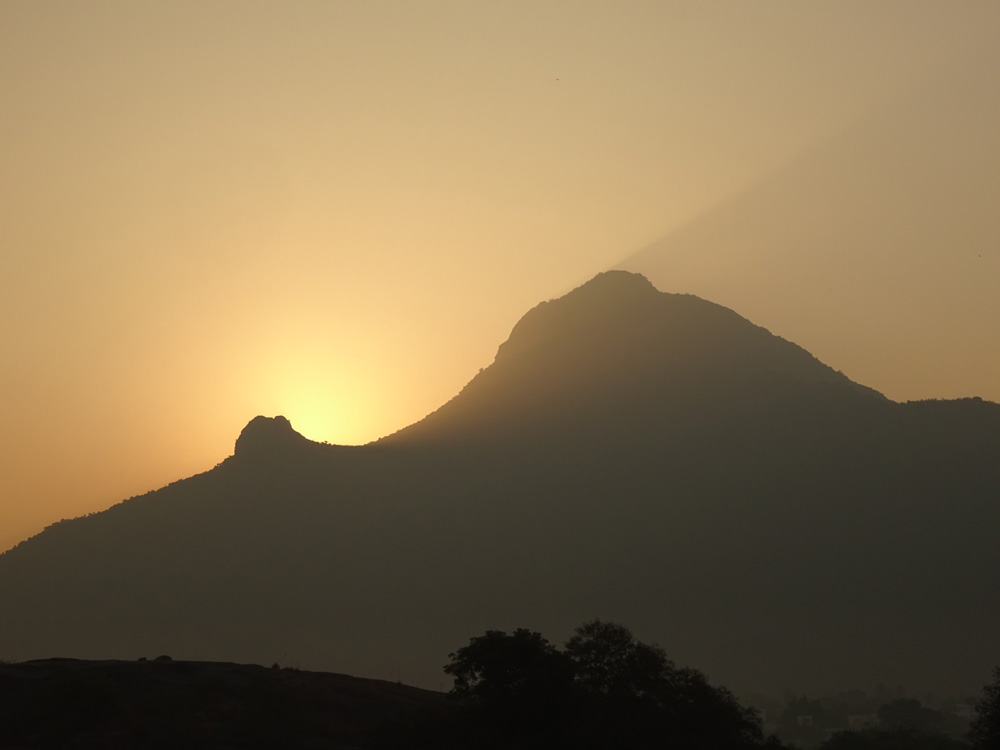
The Form of Arunachala
Sri Bhagavan has said that Arunachala is the supreme Self that shines as ‘I’ in the hearts of all living beings. In other words, Arunachala is truly the non-dual reality that transcends time, space, name and form. Hence, many of the verses in The Five Hymns to Arunachala, being very mystic in nature, can well be interpreted as applying to the nameless and formless Self, rather than to the name and form of Arunachala. For this reason, some devotees tend to view Sri Bhagavan’s revelation about the power of Arunachala as being purely allegorical, and a few even ask, ‘When Arunachala is the Self, why should we attach any particular importance to this hill’.
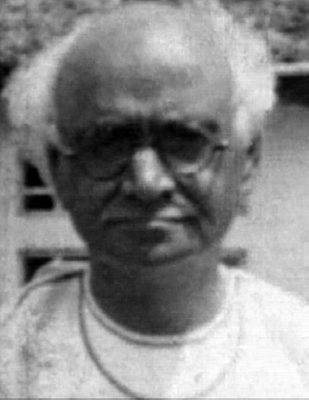
In Talks, talk no. 273, for example, it is recorded that Dr Syed asked a similar question to Sri Bhagavan, who in reply pointed out that the hill had attracted to itself all the assembled devotees, including Sri Bhagavan himself, and that the power of the hill therefore could not be denied.
In order to understand more fully the importance that Sri Bhagavan attached to the name and form of this hill, it is necessary for us to take a broad view of his teachings. In verse four of Ulladu Narpadu (The Forty Verses on Reality) Sri Bhagavan says, ‘If oneself is a form, the world and God will also be likewise’. That is, they will also be forms. In the first line of the third verse of Sri Arunachala Ashtakam he addresses Arunachala and sings, ‘When I approach you, regarding you as having form, you stand here as a hill on earth’.
That is, so long as we identify the body as ‘I’, it is equally true that this hill is God. Indeed, Sri Bhagavan used to say that because we identify the body as ‘I’, Lord Siva, the Supreme Reality, out of his immense compassion for us, identifies this hill as ‘I’, so that we may see him, think of him and thereby receive his grace and guidance. ‘Only to reveal your [transcendent] state without speech [i.e. through silence], you stand as a hill shining from earth to sky,’ sings Sri Bhagavan in the last line of the second verse of Sri Arunachala Ashtakam.
So long as we feel the name and form of our body to be ‘I’, we cannot conceive God as being anything but a name and form. Even if we think that God is formless, that very thought about God itself is a form – a mere mental conception. This is why Sri Bhagavan says in the second line of the third verse of Ashtakam, ‘If one tries to think of your nature as formless, he is like one who wanders throughout the world to see the sky’.
The futility of trying to conceive God as being formless when we are unable to know ourself as the formless Self, was well illustrated by a dialogue that Sri Bhagavan once had with some Muslims. It is recorded on p. 28 of Maha Yoga and in Talks, talk no. 121.
Being the perfect spiritual Master that he was, Sri Bhagavan knew well how important and necessary is the form of God for the human mind, which is ever attached to forms. And from his own personal experience he knew the unique power of the form of Arunachala, a power that cannot be found in such abundance in any other form of God, namely the power to turn the mind towards Self and thereby to root out the ego.
In verse eleven of Sri Arunachala Patikam Sri Bhagavan exclaims with joy and wonder, ‘Lo! How many are there like me who have been destroyed by thinking this hill to be the Supreme… ,’ thereby assuring us that if we regard this hill as God, our egos will surely be destroyed. Though Arunachala appears outwardly as a hill of mere insentient rock, the true devotee understands it to be the all-knowing, all-loving and all-powerful Supreme Lord, who is guiding him both from within and without at every step and turn of life, leading him steadily and surely towards the goal of egolessness.
‘What a wonder! It stands as if an insentient hill [yet] its action is mysterious – impossible for anyone to understand,’ sings Sri Bhagavan in the first line of Sri Arunachala Ashtakam.
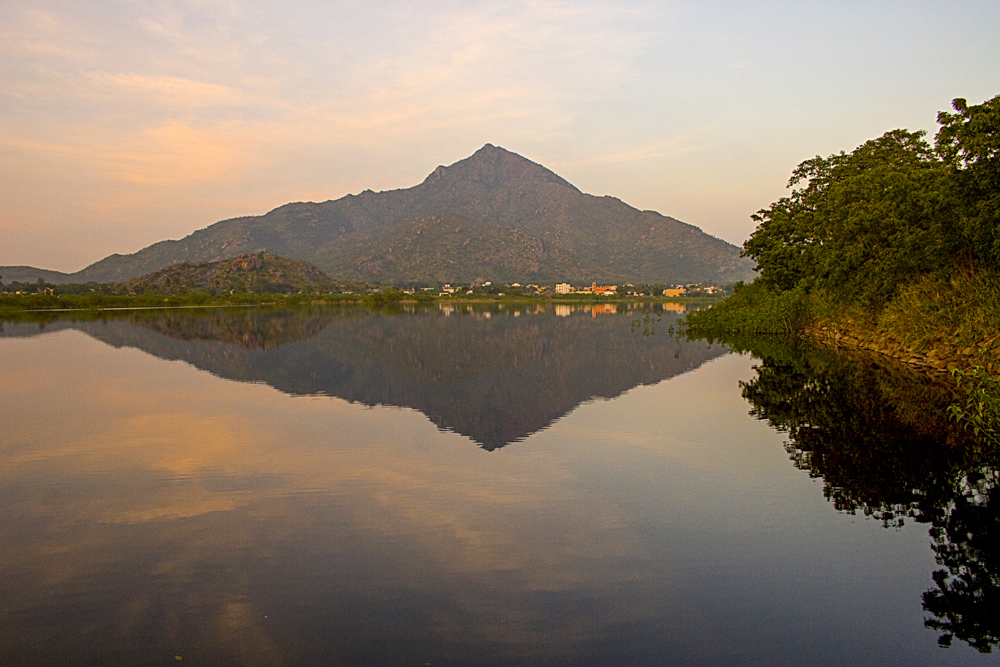
The Name of Arunachala
Of all the names of God, the name dearest to the heart of Sri Bhagavan was Arunachala. Every one of the 108 verses of Sri Arunachala Aksharamanamalai ends with the name Arunachala, and the refrain is ‘Arunachala Siva, Arunachala Siva, Arunachala Siva, Arunachala!’ From the great love that Sri Bhagavan had for this name, it is clear that he regarded it as being no less powerful than the form of Arunachala. This fact is confirmed in verse seventy of Aksharamanamalai in which Sri Bhagavan sings, ‘O Arunachala, the very moment I thought of your name, you caught me and drew me to yourself. Who can understand your greatness?’
There are many incidents in the life of Sri Bhagavan that illustrate his great love for the divine name Arunachala, but perhaps the most striking occurred during his last moments. About twenty-five minutes before he left his body, the assembled devotees began to chant Aksharamanamalai. Hearing the name of his beloved Arunachala, Sri Bhagavan opened his eyes, which shone with love, and tears of ecstasy rolled down his cheeks.
Though Sri Bhagavan never gave mantra diksha nor formally accepted anyone as his disciple, many devotees believe that Arunachala is the nama-mantra that he has bestowed upon the whole world. When a Guru formally gives a mantra to his disciple, he explains to him the meaning and significance of each letter of the mantra and tells him the fruit to be gained by meditating upon that mantra. In the same manner, in the second verse of Sri Arunachala Navamanimalai Sri Bhagavan has explained the meaning of each syllable in the name Arunachala and he has declared that mere thought of this name will bestow liberation. From this we can infer that Arunachala is the jnana-panchakshari, the five-syllable mantra that bestows jnana. Moreover, tradition tells us that when a mantra is given by a jnani and when he explains the significance of each syllable of that mantra, he is actually putting his own power into that mantra. Therefore, if any devotees of Sri Bhagavan wish to have a mantra, they can very well, take Arunachala to be the mantra openly given to them by him.
The power of the name Arunachala was once directly confirmed by Sri Bhagavan. In 1948 a certain devotee came to him from Bombay, and with him he brought a notebook in which he had written the name ‘Arunachala Siva’ many thousands of times. On the last page of this notebook the devotee wrote a prayer to the following effect, ‘O Bhagavan, in the life of Sarada Devi [the wife of Sri Ramakrishna] it is written that she has said that if even an animal dies in Kasi it will attain liberation. Therefore, graciously bestow upon be the boon of death in Kasi.’ He then gave the notebook to Sri Bhagavan.
Bhagavan looked through the notebook and when he came to the last page he read out loud the devotee’s prayer. At once he expressed the greatest surprise and exclaimed, ‘Smaranat Arunachalam!’
The words ‘Smaranat Arunachalam’ mean ‘by remembering Arunachala’, and they occur in the very same Sanskrit verse that says that by dying in Kasi one will attain liberation. Bhagavan then turned to the revolving bookcase by his side and took out a book, probably the Arunachala Mahatmyam. Opening it as if at random, he read out a sentence in Tamil that said, ‘One “Arunachala” is equal power to one crore “Om Nama Sivaya”’.
‘Om Nama Sivaya’ is believed by Saivas all over India to be the most sacred and powerful mantra. After reading out a few other portions of this book that emphasized the unique greatness and power of Arunachala, Sri Bhagavan finally laid it aside and explained to the devotee that not everyone can see Chidambaram, not everyone can be born in Tiruvarur, and not everyone can die in Kasi, but anyone and everyone can think of Arunachala from wherever they may be, and thereby they will surely attain liberation.
From this incident we can understand how unhesitatingly Sri Bhagavan encouraged devotees to have absolute faith in Arunachala. If devotees of a sceptical frame of mind came to him and asked him how mere thought of Arunachala could bestow liberation, he used to explain the allegorical significance of this saying, since that alone would satisfy their mind. An example of this can be found in Talks with Sri Ramana Maharshi, talk no.473. But if devotees came to him with simple, child-like faith, he would strengthen their faith and confirm the literal meaning of this saying, since he knew from personal experience the great power of the name and form of Arunachala.
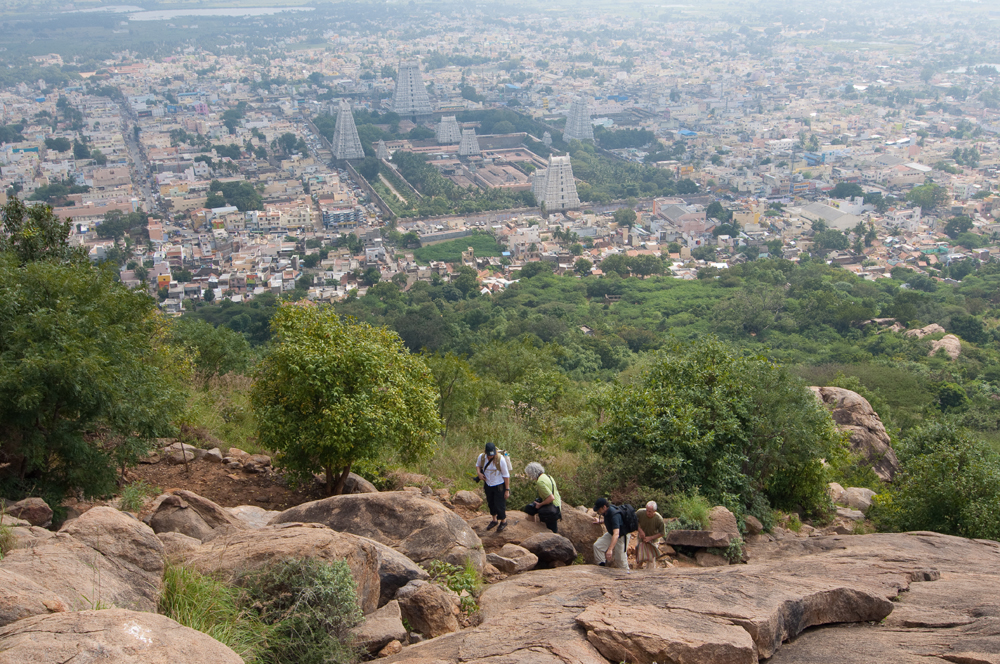
The Unique Sanctity of Arunachala
In India there are countless holy places (kshetras) that are sacred to Lord Siva or to some other name and form of God, and many of them are more well-known and popular than Arunachala. Yet there is a verse in the Arunachala Mahatmyam, which has been selected and translated into Tamil by Sri Bhagavan, that says:
Arunachala is truly the holy place. Of all holy places it is the most sacred! Know that it is the heart of the world. It is truly Siva himself! It is his heart-abode, a secret kshetra. In that place the Lord ever abides the hill of light named Arunachala.
Whenever Sri Bhagavan asked about the special sanctity of Arunachala, he used to explain that other holy places such as Kailas, Kasi and Chidambaram are sacred because they are the abodes of Lord Siva whereas Arunachala is Lord Siva himself. (See Talks with Sri Ramana Maharshi, talk no. 143, and Sri Ramana Reminiscences, p. 37 for examples of this). However, as the above verse of Arunachala Mahatmyam says, Arunachala is a secret kshetra. Because it is this place that bestows jnana and because most people have so many other desires and do not truly want jnana, Arunachala has always remained comparatively little known. But to those few who seek jnana, Arunachala always makes itself known through some means or other.
The unique sanctity and power of Arunachala-kshetra was once confirmed by an incident that happened in the life of Sri Bhagavan. Because of his great love for Sri Bhagavan, a certain devotee wanted to take him to his native place, Chidambaram. But rather than directly ask Sri Bhagavan to come to Chidambaram, he began to ask him if he had ever been to see Lord Nataraja in Chidambaram Temple. When Sri Bhagavan replied that he had not, the devotee began to describe the greatness of Chidambaram, saying that it was the most sacred Siva-kshetra in South India, that so many saints and sages had lived there and had sung in praise of Lord Nataraja, and so on and so forth. Sri Bhagavan listened to all he said with patient interest, but showed no signs of wanting to visit Chidambaram.
Seeing this, the devotee at last said, ‘Chidambaram is even greater than Arunachala, because among the panchabuta lingams [the lingams representing the five elements] Chidambaram is the space-lingam while Arunachala is only the fire-lingam. Since the four elements, earth, water, air and fire, finally have to merge in space, space is the principal element.’
Though Arunachala is generally considered to be one of the panchabhuta-lingams, Sri Bhagavan used to point out that It is truly not a lingam of ordinary fire, which is one among the five gross elements, but is a lingam of the fire of knowledge (jnanagni), the fire that burns the ego to destruction.
After Sri Bhagavan had heard this explanation, he smiled and said, ‘All the five elements come into existence only when Sakti seemingly forsakes her identify with Lord Siva, the Supreme Self (Paramatman). Since the five elements are thus only the creations of Sakti, she is superior to all of them. Therefore, more important than the place where the elements merge, is the place where Sakti herself merges. Because Sakti is dancing in Chidambaram, Lord Siva has to dance before her and thereby make her become motionless. But in Arunachala Lord Siva remains ever motionless (achala), and hence Sakti automatically and effortlessly merges in him through great love. Therefore, Arunachala shines as the foremost and most powerful kshetra, because here Sakti, who has seemingly created all this manifold appearance, herself merges into the Lord. So for those mature aspirants who seek to put an end to the false appearance of duality, the most powerful help is to be found only in Arunachala-kshetra.’
Subsequently, on 24th June 1928, Sri Bhagavan summarized this reply of his in the form of a verse, which later became the first verse of Sri Arunachala Navamanimalai. In this verse he says:
Though he is truly motionless by nature, in the court [of Chidambaram] Lord Siva dances before Sakti, thereby making her motionless. But know that [in Tiruvannamalai] Lord Arunachala shines triumphant, that Sakti having merged in his motionless form.
